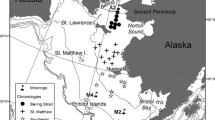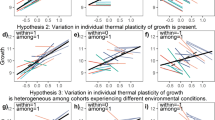Abstract
Otolith growth-increment chronologies provide an approach for evaluating the impacts of both high-frequency (e.g., interannual) and low-frequency (e.g., interdecadal) climate variability on fish growth. A growth-increment biochronology spanning six decades, spanning several warm and cold climate regime periods, was developed for a commercially important species of rockfish, Sebastes polyspinis, in the Gulf of Alaska. To confirm that all increments were correctly identified and placed in time, we borrowed the technique of crossdating from the tree-ring science of dendrochronology, which ensured high data quality. We then used a mixed effects model to partition variance in otolith growth-increment width among intrinsic (e.g., age-related) and extrinsic (e.g., climate-related) factors. This biochronology was contrasted with one recently developed for S. alutus, a closely-related species which exhibited a significant change in growth following the late 1970s North Pacific climate regime shift. Both species generally showed positive relationships between warm climate conditions and growth, though S. polyspinis experienced a relatively smaller step-increase in growth following the regime shift. The new S. polyspinis otolith biochronology represents a long-term record of growth that extends well before biological specimens were first collected in the Gulf of Alaska, providing a potential tool for fisheries managers to evaluate the effects of climate variability on growth and biological reference points.






Similar content being viewed by others
References
Anderson PJ, Piatt JF (1999) Community reorganization in the Gulf of Alaska following ocean climate regime shift. Mar Ecol Prog Ser 189:117–123
Barrow J, Ford J, Day R, Morrongiello J (in press) Environmental drivers of growth and predicted effects of climate change on a commercially important fish. Mar Ecol Prog Ser. https://doi.org/10.3354/meps12234
Black BA (2009) Climate-driven synchrony across tree, bivalve, and rockfish growth-increment chronologies of the Northeast Pacific. Mar Ecol Prog Ser 378:37–46. https://doi.org/10.3354/Meps07854
Black BA, Boehlert GW, Yoklavich MM (2005) Using tree-ring crossdating techniques to validate annual growth increments in long-lived fishes. Can J Fish Aquat Sci 62(10):2277–2284
Black BA, Boehlert GW, Yoklavich MM (2008) Establishing climate-growth relationships for yelloweye rockfish (Sebastes ruberrimus) in the Northeast Pacific using a dendrochronological approach. Fish Oceanogr 17(5):368–379
Black BA, Schroeder ID, Sydeman WJ, Bograd SJ, Wells BK, Schwing FB (2011) Winter and summer upwelling modes and their biological importance in the California current ecosystem. Glob Chang Biol 17(8):2536–2545. https://doi.org/10.1111/j.1365-2486.2011.02422.x
Black BA, Matta ME, Helser TE, Wilderbuer TK (2013) Otolith biochronologies as multidecadal indicators of body size anomalies in yellowfin sole (Limanda aspera). Fish Oceanogr 22(6):523–532. https://doi.org/10.1111/fog.12036
Black BA, Sydeman WJ, Frank DC, Griffin D, Stahle DW, Garcia-Reyes M, Rykaczewski RR, Bograd SJ, Peterson WT (2014) Six centuries of variability and extremes in a coupled marine-terrestrial ecosystem. Science 345(6203):1498–1502. https://doi.org/10.1126/science.1253209
Black BA, Griffin D, van der Sleen P, Wanamaker AD Jr, Speer JH, Frank DC, Stahle DW, Pederson N, Copenheaver CA, Trouet V, Griffin S, Gillanders BM (2016) The value of crossdating to retain high-frequency variability, climate signals, and extreme events in environmental proxies. Glob Chang Biol 22(7):2582–2595. https://doi.org/10.1111/gcb.13256
Bunn AG (2008) A dendrochronology program library in R (dplR). Dendrochronologia 26(2):115–124. https://doi.org/10.1016/j.dendro.2008.01.002
Burnham KP, Anderson DR (2002) Model selection and multimodel inference: a practical information-theoretic approach, 2nd edn. Springer, New York
Butler PG, Richardson CA, Scourse JD, Wanamaker AD, Shammon TM, Bennell JD (2010) Marine climate in the Irish Sea: analysis of a 489-year marine master chronology derived from growth increments in the shell of the clam Arctica islandica. Quat Sci Rev 29(13–14):1614–1632. https://doi.org/10.1016/j.quascirev.2009.07.010
Campana SE (1999) Chemistry and composition of fish otoliths: pathways, mechanisms and applications. Mar Ecol Prog Ser 188:263–297
Clausen DM, Heifetz J (2002) The northern rockfish, Sebastes polyspinis, in Alaska: commercial fishery, distribution, and biology. Mar Fish Rev 64(4):1–28
Development Core Team R (2016) R: a language and environment for statistical computing. R Foundation for Statistical Computing, Vienna
Douglass AE (1920) Evidence of climatic effects in the annual rings of trees. Ecology 1(1):24–32
Esper J, Cook ER, Krusic PJ, Peters K, Schweingruber FH (2003) Tests of the RCS method for preserving low-frequency variability in long tree-ring chronologies. Tree-Ring Res 59(2):81–98
Fritts HC (1976) Tree rings and climate. Blackburn Press, Caldwell
Gargett AE (1997) The optimal stability `window': a mechanism underlying decadal fluctuations in North Pacific salmon stocks? Fish Oceanogr 6(2):109–117
Gharrett AJ, Riley RJ, Spencer PD (2012) Genetic analysis reveals restricted dispersal of northern rockfish along the continental margin of the Bering Sea and Aleutian Islands. Trans Am Fish Soc 141(2):370–382. https://doi.org/10.1080/00028487.2012.662419
Goetz BJ, Piston CE, Gburski CM (2012) Rockfish (Sebastes) species, p. 49-64. In: Matta ME, Kimura DK (eds), Age determination manual of the Alaska fisheries science center age and growth program. US Dep Commer, NOAA Prof Paper NMFS 13. https://spo.nmfs.noaa.gov/sites/default/files/PP13.pdf
Grissino-Mayer HD (2001) Evaluating crossdating accuracy: a manual and tutorial for the computer program COFECHA. Tree-Ring Res 57(2):205–221
Hare SR, Mantua NJ (2000) Empirical evidence for North Pacific regime shifts in 1977 and 1989. Prog Oceanogr 47(2–4):103–145. https://doi.org/10.1016/S0079-6611(00)00033-1
Helser TE, Lai HL, Black BA (2012) Bayesian hierarchical modeling of Pacific geoduck growth increment data and climate indices. Ecol Model 247:210–220. https://doi.org/10.1016/j.ecolmodel.2012.08.024
Holmes RL (1983) Computer-assisted quality control in tree-ring dating and measurement. Tree-Ring Bull 43:69–78
Hulson PJF, Heifetz J, Hanselman DH, Shotwell SK, Ianelli JN (2015) Assessment of the northern rockfish stock in the Gulf of Alaska. North Pacific Fishery Management Council, Anchorage, pp 889–974 https://www.afsc.noaa.gov/REFM/Docs/2015/GOAnork.pdf
Kastelle CR, Helser TE, Wischniowski SG, Loher T, Goetz BJ, Kautzi LA (2016) Incorporation of bomb-produced 14C into fish otoliths: a novel approach for evaluating age validation and bias with an application to yellowfin sole and northern rockfish. Ecol Model 320:79–91. https://doi.org/10.1016/j.ecolmodel.2015.09.013
King JR, McFarlane GA (2003) Marine fish life history strategies: applications to fishery management. Fisheries Manag Ecol 10(4):249–264
Li Z, Gray AK, Love MS, Goto A, Gharrett AJ (2007) Are the subgenera of Sebastes monophyletic? In: Heifetz J, DiCosimo J, Gharrett AJ, Love MS, O'Connell VM, Stanley RD (eds) Biology, assessment, and Management of North Pacific Rockfishes. vol AK-SG-07-01. Alaska Sea Grant College Program, p 185-206
Love MS, Yoklavich M, Thorsteinson L (2002) The rockfishes of the Northeast Pacific. University of California Press, Berkeley
Mantua NJ, Hare SR, Zhang Y, Wallace JM, Francis RC (1997) A Pacific interdecadal climate oscillation with impacts on salmon production. Bull Am Meteorol Soc 78(6):1069–1079
Matta ME, Kimura DK (2012) Age determination manual of the Alaska fisheries science center. US Dep Commer, NOAA Prof Paper NMFS 13
Matta ME, Black BA, Wilderbuer TK (2010) Climate-driven synchrony in otolith growth-increment chronologies for three Bering Sea flatfish species. Mar Ecol Prog Ser 413:137–145. https://doi.org/10.3354/meps08689
Matta ME, Helser TE, Black BA (2016) Otolith biochronologies reveal latitudinal differences in growth of Bering Sea yellowfin sole Limanda aspera. Polar Biol 39(12):2427–2439. https://doi.org/10.1007/s00300-016-1917-y
Mazloumi N, Burch P, Fowler AJ, Doubleday ZA, Gillanders BM (2017) Determining climate-growth relationships in a temperate fish: a sclerochronological approach. Fish Res 186:319–327. https://doi.org/10.1016/j.fishres.2016.10.012
Meyer SC (2000) Composition and biomass of the recreational rockfish Sebastes harvest in Southcentral Alaska, 1992-1995. Alaska Department of Fish and Game, Anchorage, AK, Fishery Data Series No 00–6, 106 p
Morrongiello JR, Thresher RE (2015) A statistical framework to explore ontogenetic growth variation among individuals and populations: a marine fish example. Ecol Monogr 85(1):93–115. https://doi.org/10.1890/13-2355.1
Morrongiello JR, Thresher RE, Smith DC (2012) Aquatic biochronologies and climate change. Nat Clim Chang 2(12):849–857. https://doi.org/10.1038/nclimate1616
Morrongiello JR, Walsh CT, Gray CA, Stocks JR, Crook DA (2014) Environmental change drives long-term recruitment and growth variation in an estuarine fish. Glob Chang Biol 20(6):1844–1860. https://doi.org/10.1111/gcb.12545
Nakagawa S, Schielzeth H (2013) A general and simple method for obtaining R 2 from generalized linear mixed-effects models. Methods Ecol Evol 4(2):133–142. https://doi.org/10.1111/j.2041-210x.2012.00261.x
Neuheimer AB, Thresher RE, Lyle JM, Semmens JM (2011) Tolerance limit for fish growth exceeded by warming waters. Nat Clim Chang 1(2):110–113. https://doi.org/10.1038/nclimate1084
Ong JJL, Rountrey AN, Meeuwig JJ, Newman SJ, Zinke J, Meekan MG (2015) Contrasting environmental drivers of adult and juvenile growth in a marine fish: implications for the effects of climate change. Sci Rep 5. https://doi.org/10.1038/Srep10859
Ong JJL, Rountrey AN, Marriott RJ, Newman SJ, Meeuwig JJ, Meekan MG (2017) Cross-continent comparisons reveal differing environmental drivers of growth of the coral reef fish, Lutjanus bohar. Coral Reefs 36(1):195–206. https://doi.org/10.1007/s00338-016-1520-2
Palof KJ, Heifetz J, Gharrett AJ (2011) Geographic structure in Alaskan Pacific Ocean perch (Sebastes alutus) indicates limited lifetime dispersal. Mar Biol 158(4):779–792. https://doi.org/10.1007/s00227-010-1606-2
Pinheiro JC, Bates DM (2000) Mixed-effects models in S and S-plus. Springer, New York
Rayner NA (2003) Global analyses of sea surface temperature, sea ice, and night marine air temperature since the late nineteenth century. J Geophys Res 108(D14):4407. https://doi.org/10.1029/2002jd002670
Ricker WE (1969) Effects of size-selective mortality and sampling bias on estimates of growth, mortality, production, and yield. J Fish Res Board Can 26:479–541
Speer JH (2010) Fundamentals of tree-ring research. University of Arizona Press, Tucson
Stachura MM, Essington TE, Mantua NJ, Hollowed AB, Haltuch MA, Spencer PD, Branch TA, Doyle MJ (2014) Linking Northeast Pacific recruitment synchrony to environmental variability. Fish Oceanogr 23(5):389–408. https://doi.org/10.1111/fog.12066
Thompson JE, Hannah RW (2010) Using cross-dating techniques to validate ages of aurora rockfish (Sebastes aurora): estimates of age, growth and female maturity. Environ Biol Fish 88(4):377–388. https://doi.org/10.1007/s10641-010-9653-6
van der Sleen P, Dzaugis MP, Gentry C, Hall WP, Hamilton V, Helser TE, Matta ME, Underwood CA, Zuercher R, Black BA (2016) Long-term Bering Sea environmental variability revealed by a centennial-length biochronology of Pacific Ocean perch Sebastes alutus. Clim Res 71(1):33–45. https://doi.org/10.3354/cr01425
von Biela VR, Kruse GH, Mueter FJ, Black BA, Douglas DC, Helser TE, Zimmerman CE (2015) Evidence of bottom-up limitations in nearshore marine systems based on otolith proxies of fish growth. Mar Biol 162(5):1019–1031. https://doi.org/10.1007/s00227-015-2645-5
von Biela VR, Zimmerman CE, Kruse GH, Mueter FJ, Black BA, Douglas DC, Bodkin JL (2016) Influence of basin- and local-scale environmental conditions on nearshore production in the Northeast Pacific Ocean. Mar Coast Fish 8(1):502–521. https://doi.org/10.1080/19425120.2016.1194919
Wigley TML, Briffa KR, Jones PD (1984) On the average value of correlated time series, with applications in dendroclimatology and hydrometerology. Journal of Climate and Applied Meterology 23:201–213
Wilderbuer TK, Nichol DG, Ianelli J (2016) Assessment of the yellowfin sole stock in the Bering Sea and Aleutian Islands. North Pacific Fishery Managment Council, Anchorage, pp 803–894 https://www.afsc.noaa.gov/REFM/Docs/2016/BSAIyfin.pdf
Wolotira RJJ, Sample TM, Noel SF, Iten CR (1993) Geographic and bathymetric distributions for many commercially important fishes and shellfishes off the west coast of North America, based on research survey and commercial catch data, 1912–84. US Dep Commer, NOAA Tech Memo NMFS-AFSC-6, 184 p
Worton CL, Rosenkranz GE (2003) Sex, age, and growth of black rockfish Sebastes melanops from a newly exploited population in the Gulf of Alaska, 1993-1999. Alaska Fish Res Bull 10(1):14–27
Yang MS, Nelson MW (2000) Food habits of the commercially important groundfishes in the Gulf of Alaska in 1990, 1993, and 1996. US Dep Commer, NOAA Tech Memo NMFS-AFSC-112, 174 p
Zuur AF, Ieno EN, Walker NJ, Saveliev AA, Smith GM (2009) Mixed effects models and extensions in ecology with R. Springer, New York
Acknowledgements
We thank Christopher Gburski for assisting with otolith preparation. The R scripts published in Morrongiello and Thresher (2015) were invaluable in the construction of our mixed effects models, and we thank the authors for making this information freely available. We thank Kim Rand, Chris Rooper, and two anonymous reviewers for providing constructive reviews that improved this manuscript. All applicable federal guidelines for the care and use of animals were followed. Reference to trade names does not imply endorsement by the National Marine Fisheries Service, NOAA. The findings and conclusions in the paper are those of the authors and do not necessarily represent the views of the National Marine Fisheries Service, NOAA.
Author information
Authors and Affiliations
Corresponding author
Electronic supplementary material
ESM 1
(DOCX 18 kb)
Rights and permissions
About this article
Cite this article
Matta, M.E., Helser, T.E. & Black, B.A. Intrinsic and environmental drivers of growth in an Alaskan rockfish: an otolith biochronology approach. Environ Biol Fish 101, 1571–1587 (2018). https://doi.org/10.1007/s10641-018-0801-8
Received:
Accepted:
Published:
Issue Date:
DOI: https://doi.org/10.1007/s10641-018-0801-8




